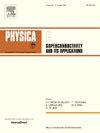储能线圈用高温超导体的力学和淬火行为分析
IF 1
3区 物理与天体物理
Q4 PHYSICS, APPLIED
Physica C-superconductivity and Its Applications
Pub Date : 2025-09-08
DOI:10.1016/j.physc.2025.1354787
引用次数: 0
摘要
超导材料表现出优异的电磁特性,如零电阻和迈斯纳效应。这些特性使超导材料在能源、交通、电力、医疗、电信和航空航天等现代领域具有广泛的应用潜力。然而,超导材料通常在一个复杂的环境中工作,其特征是极低的温度、强磁场和显著的电流水平。在轻微的热、机械、电、磁扰动下,容易发生淬火,可能危及系统的稳定性和安全性。为此,为了减少淬火对超导系统的损伤,本文从理论上研究了超导复合材料和结构在淬火过程中的多场耦合特性和热塑性响应。首先,利用高温超导储能线圈的几何构型,建立了超导带多层复合结构的有限元模型;其次,通过瞬态电磁场方程和热传导方程的耦合,研究了不同温度下局部热扰动引起的淬火行为。研究表明,淬火过程中应变的瞬时演化与温度变化密切相关。在远离热源的侧向位置,应变呈现先减小后增大的趋势,在应变曲线上有明显的最小值点。然而,在靠近热源的位置,应变表现出连续增长的特征。此外,随着淬火的进一步发展,非淬火区拉伸应变的增长速度明显加快。即淬火区域的热膨胀可以通过中间层传递到未淬火区域,导致这些区域发生机械变形。这一现象为高温超导结构的淬火检测提供了新的视角和技术途径。本文章由计算机程序翻译,如有差异,请以英文原文为准。
Analysis of mechanical and quench behavior in high-temperature superconductors for energy storage coils
Superconducting materials exhibit superior electromagnetic properties, such as zero electrical resistance and the Meissner effect. These characteristics endow superconducting materials with extensive application potential across contemporary sectors including energy, transportation, electric power, healthcare, telecommunications, and aerospace. However, superconducting materials typically operate within a sophisticated environment characterized by extremely low temperatures, intense magnetic fields, and significant current levels. Under the slight thermal, mechanical, electrical and magnetic disturbances, quenching is easy to occur, potentially endangering the stability and security of the system. For this reason, in order to reduce the damage to the superconducting system caused by quench, the multi-field coupling characteristics and thermoplastic response of superconducting composites and structures during quench are theoretically studied in this paper. Firstly, utilizing the geometric configuration of the high-temperature superconducting (HTS) energy storage coil, a finite element model of the multi-layer composite structure of the superconducting tape is established. Secondly, the quench behavior resulting from local thermal disturbances at various temperatures is investigated through the coupling of transient electromagnetic field equations and heat conduction equations. Studies indicate that the instantaneous evolution of strain is closely correlated with temperature changes during the quenching process. At positions laterally distant from the heat source, the strain exhibits an initial decreasing trend followed by an increase, characterized by a distinct minimum point on the strain curve. However, at locations proximal to the heat source, the strain demonstrates a characteristic of continuous growth. Besides, with the further development of quenching, the growth rate of tensile strain in the unquenched region is obviously accelerated. That is, the thermal expansion in the quenched region can be transmitted to the unquenched regions through the interlayer, resulting in mechanical deformation in these regions. This phenomenon can provide a new perspective and technical approach for quench detection of high temperature superconducting structures.
求助全文
通过发布文献求助,成功后即可免费获取论文全文。
去求助
来源期刊
CiteScore
2.70
自引率
11.80%
发文量
102
审稿时长
66 days
期刊介绍:
Physica C (Superconductivity and its Applications) publishes peer-reviewed papers on novel developments in the field of superconductivity. Topics include discovery of new superconducting materials and elucidation of their mechanisms, physics of vortex matter, enhancement of critical properties of superconductors, identification of novel properties and processing methods that improve their performance and promote new routes to applications of superconductivity.
The main goal of the journal is to publish:
1. Papers that substantially increase the understanding of the fundamental aspects and mechanisms of superconductivity and vortex matter through theoretical and experimental methods.
2. Papers that report on novel physical properties and processing of materials that substantially enhance their critical performance.
3. Papers that promote new or improved routes to applications of superconductivity and/or superconducting materials, and proof-of-concept novel proto-type superconducting devices.
The editors of the journal will select papers that are well written and based on thorough research that provide truly novel insights.

 求助内容:
求助内容: 应助结果提醒方式:
应助结果提醒方式:


